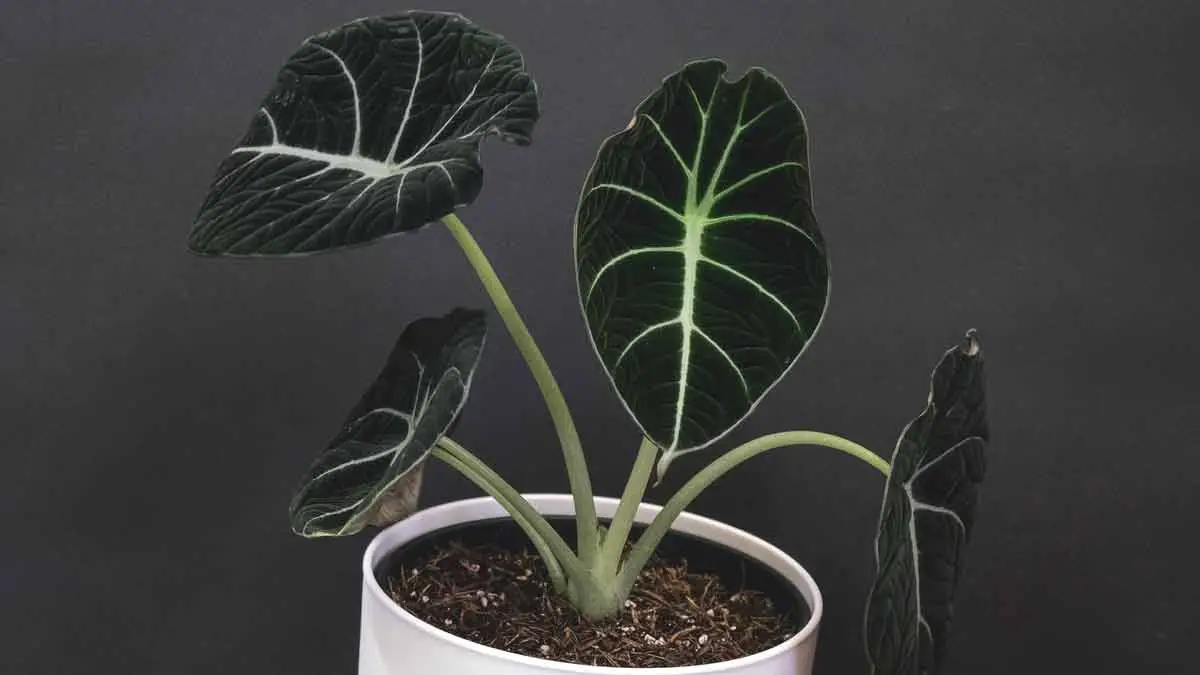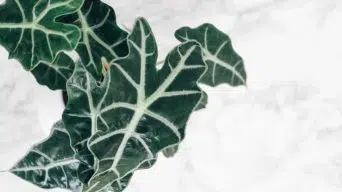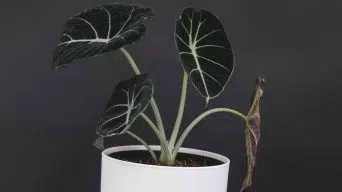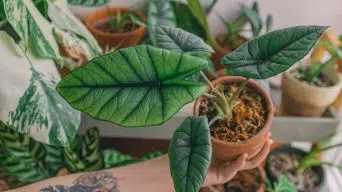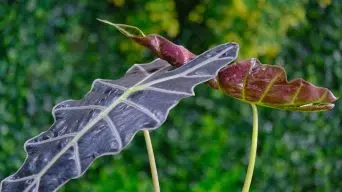Alocasia plants are beautiful tropical plants that are often grown as houseplants.
They are prized for their large, glossy leaves, which can add a touch of the tropics to any home.
Unfortunately, Alocasias are also susceptible to a disease called root rot.
However, there are some things that you can do to save your Alocasia from root rot and keep it healthy.
What Is Root Rot?
Root rot is a disease that affects the roots of plants. It is caused by a fungus or bacteria that gets into the plant through the roots.
The fungus or bacteria then grows and multiplies, causing the roots to rot.
Root rot can be fatal to plants, so it is vital to catch it early and take steps to treat it.
What Causes Root Rot?
There are several reasons why your Alocasia plant could be experiencing root rot.
These include:
Overwatering
Overwatering is one of the most common causes of root rot. When the roots of a plant are constantly wet, it provides the perfect environment for fungi and bacteria to grow.
This usually happens when the plant is kept in an environment that is too humid or watered too often.
When a plant is overwatered, the roots can’t get the oxygen they need to function correctly and start to rot.
An overwatered Alocasia won’t be able to take up water and nutrients properly, which can lead to the plant wilting and the leaves turning yellow.
Underwatering
Underwatering can cause root rot, although overwatering is not as common.
When a plant is underwatered, the roots can dry out and become damaged. This provides an opportunity for fungi and bacteria to enter the plant and cause the roots to rot.
An underwatered Alocasia will have dry, yellow leaves. The roots may also be dry and discolored.
Poor Drainage
If the pot that your Alocasia is in does not have proper drainage, this can lead to root rot.
When the roots of a plant are constantly wet, it can cause them to rot.
Poor drainage can also lead to overwatering, as the water will not be able to drain away from the roots properly.
A pot with poor drainage will have water sitting at the bottom of it after watering. The roots of the plant may also be sitting in water.
A poor draining potting mix can also cause root rot, even if the pot has good drainage.
If the potting mix does not drain well, the plant’s roots can become waterlogged and start to rot.
Compacted Soil
Compacted soil can also lead to root rot.
When the potting soil is too compacted, it doesn’t allow air to circulate properly, and the roots can start to rot.
This is often a problem in pots that have not been repotted for a long time. The roots of the plant can become potbound and start to rot.
A plant growing in compacted soil will have yellow leaves and stunted growth. The roots may also be discolored.
Fungal Diseases
Fungal diseases can also cause root rot. These diseases are caused by fungi that attack the roots of the plant.
The most common fungal disease that affects Alocasias is Pythium root rot. This disease is caused by a fungus called Pythium spp.
Pythium root rot often affects plants growing in wet or poorly drained soils. The roots of the plant start to rot, and the plant wilts.
The leaves of the plant may turn yellow or brown and fall off. Pythium root rot can be fatal to plants if not treated quickly.
Root Damage
Damage to the roots of a plant can also lead to root rot. This can be caused by physical damage, such as from digging or trampling.
It can also be caused by chemicals, such as herbicides or insecticides.
When the roots are damaged, it provides an opportunity for fungi and bacteria to enter the plant and cause the roots to rot.
A plant with damaged roots will often have stunted growth or yellow leaves.
The roots may also be discolored or mushy.
What Does Alocasia Root Rot Look Like?
Root rot can cause several different symptoms in Alocasias. These symptoms can vary depending on the cause of the root rot.
Some of the most common symptoms include:
Wilting
One of the most common symptoms of root rot is wilting.
When the roots of a plant are rotting, they cannot take up water and nutrients properly.
This can cause the Alocasia leaves to droop and wilt, as it is not getting the water it needs.
Wilting can occur suddenly or gradually, depending on the severity of the root rot.
Yellowing Leaves
Root rot can also cause the leaves of a plant to turn yellow. This is often a symptom of overwatering, as the roots cannot take up water properly.
The Alocasia leaves may start to yellow at the tips and edges and then progress down the leaves.
Eventually, the entire leaf may turn yellow and fall off.
Brown Leaves
Leaves that turn brown and mushy are another symptom of root rot.
This is often caused by a fungal infection.
The alocasia leaves may start to brown at the tips and edges and then progress down the leaves. Eventually, the entire leaf may turn brown and fall off.
Black Spots on Leaves
Black spots on the leaves can also be a symptom of root rot.
This is often caused by a fungal infection.
The black spots may start small, but they can quickly spread and cover the entire leaf.
The leaves may also turn yellow or brown and eventually drop off.
Soggy Soil
Soggy soil is another symptom of root rot.
This is often caused by overwatering, as the roots cannot take up water properly.
The soil may feel wet and mushy and may be darker in color than usual.
Bad Smell
A foul smell can also be a symptom of root rot.
This is often caused by bacteria that are present in the waterlogged roots.
The roots may start to decompose and release a foul odor.
Mushy and Black Roots
Mushy and black roots are another symptom of root rot.
When the roots start to rot, they can become mushy and discolored
They may also fall off of the plant easily
Healthy roots are white or light-colored and firm.
Stunted Growth
Root rot can also cause stunted growth in Alocasias.
When the roots rot, they cannot take up water and nutrients properly. This can cause the plant to stop growing or to grow very slowly.
The leaves of the plant may also be smaller than normal.
How To Treat Alocasia Root Rot
If you suspect that your Alocasia has root rot, it is essential to take action quickly.
Root rot can spread quickly and kill a plant if it is not treated.
Here is a step-by-step guide on how to treat root rot in Alocasias:
1. Remove the Plant from the Pot
The first step is to remove the plant from the pot.
Gently turn the pot over and gently tap it on the ground until the plant slides out.
2. Inspect the Roots
Once the plant is out of the pot, inspect the roots.
Look for any roots that are mushy, discolored, or falling off.
You can tell if a root is healthy if it is white or light-colored and firm.
3. Clean the Roots
The next step is to clean the roots.
Gently rinse the roots with clean water.
This will remove any dirt, debris, or bacteria that may be present.
4. Cut Off Damaged Roots
Once you have identified the damaged roots, use a pair of sharp scissors to cut them off.
Be sure to cut at least 2 inches below the damage.
Be careful not to damage the healthy roots.
4. Discard the Soil and Replace it With Fresh Soil
Once you have removed the damaged roots, discard the old soil.
Do not replant the Alocasia in the same soil.
Instead, replace it with a fresh, well-draining potting soil mix.
5. Wash the Pot
Wash the pot with soap and water before replanting the Alocasia.
This will remove any bacteria or fungi that may be present.
6. Replant the Alocasia
Once you have prepared the pot, gently replant the Alocasia.
Backfill the pot with fresh soil and water lightly.
7. Place the Plant in a Bright Indirect Sunlight
After replanting the Alocasia, place it in bright indirect light.
Too much direct sunlight can scorch the leaves.
How To Prevent Alocasia Root Rot
You can do a few things to prevent root rot in Alocasias.
Here are a few tips:
1. Use Well-Draining Soil
Be sure to use a well-draining potting mix when planting Alocasias.
This will help to prevent the roots from becoming waterlogged.
2. Water When the Soil is Dry
Be sure to water only when the soil is dry.
Overwatering can cause the roots to rot, so be sure to allow the soil to dry out in between waterings.
3. Avoid Getting Water on the Leaves
When watering Alocasias, be sure to avoid getting water on the leaves.
Water on the leaves can cause the houseplant to develop fungal diseases.
4. Use Pots with Drainage Holes
When potting Alocasias, be sure to use pots with drainage holes.
This will allow the water to drain out of the pot and help to prevent the roots from becoming waterlogged.
5. Provide Good Air Circulation
Be sure to provide good air circulation around the Alocasia.
This will help to prevent the development of fungal diseases.
You can provide good air circulation by placing your indoor plant in a well-ventilated area.
6. Repot in New Soil Every Year
Be sure to repot Alocasias in new soil every year.
This will help to prevent the build-up of disease-causing organisms in the potting mix.
It also allows for fresh nutrients to be added to the plant.
7. Prune Off Damaged or Dead Leaves
Be sure to prune off any damaged or dead leaves.
This will help to prevent the spread of diseases and pests.
It also allows the plant to focus its energy on new growth.
8. Remove Debris From Around the Plant
Be sure to remove any debris from around the plant.
This includes dead leaves, twigs, and branches.
Debris can provide a place for diseases and pests to hide and multiply.
It also can block air circulation and lead to fungal diseases.
9. Monitor the Plant for Signs of Disease or Pests
Be sure to monitor your houseplant for signs of disease or pests.
If you see any, be sure to treat them immediately.
The sooner you catch and treat diseases and pests, the better your chances of saving the plant.
10. Quarantine New Plants
Be sure to quarantine new plants.
This will help to prevent the spread of diseases and pests.
It also allows you to monitor the plant for signs of disease or pests.
If you see any, be sure to treat them immediately.
Final Thoughts
Alocasia root rot is a severe problem that can kill the plant.
If you think your Alocasia has root rot, act quickly.
The sooner you catch and treat the problem, the better the chance of saving the plant.
Following these tips can help keep your Alocasia healthy and happy for years.

